The fascinating world of bees
Calendar of bees
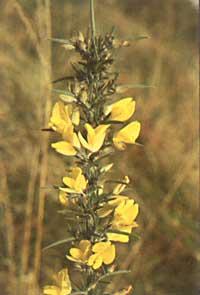
If you look at the porch of a bee or hive, we can learn many things, since in the port you can see many internal incidents.
Winter
Nine years ago, when the first bee came home, it was autumn and that winter we visited that bee several times. I remember well that when my brother and I left at once and we did not see any movement in the gate we were afraid if he died and we did not feel calm until we left a few hitting the hive.
In winter the bee is asleep and does not look much at the goal if a beautiful sun does not sound. When the sun warms the bees are seen in the port and they are also expelled flying. Even before the willow begins to bloom, some of them bring pollen from some hidden flower. It is usually in bloom in winter and gets a lot of pollen removed.
However, in general, the bees that appear in the port in winter come out to enjoy the mild weather, but this has nothing to do with collecting pollen or nectars. Among those who seek the sun, we can hardly see an erlamando. They are all workers. If the year has been mild, some remain on the coast.
Spring
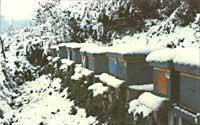
The march of the year means a lot, but by March a great movement begins in the port. In the legs stand the yellow pollen balls and the entrance and exit through the port is large.
Among us spring usually has great ups and downs and if after a temper the ice is added, in the following days we can see some white bees. They are children who have died cold. That is, when the cold strike comes, the bees accumulate to cope with the cold and if there are not enough bees to cover the children who had made, the children cool and die. Once the temperate arrives, the rooms where the dead are found are cleaned and the queens are ready to make eggs.
When they spend the winter and make the first flights, they are often perched on stones, when the weather is mild. There they empty their intestine, part of the whole winter, leaving a cocoa thread up to two centimeters in diameter. In fact, if winter has been hard, for all the time you have been out do not make cocoa inside the hive and accumulate it in your intestines.
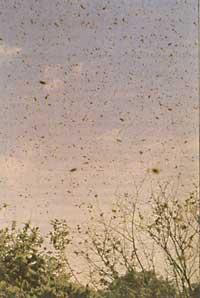
Despite the differences between years and regions, by April we can see the first noisy shields. Although it is said that the erlamandarras throw them in autumn, they can do it in May if the environment is bad.
If a good beekeeper wants to know how the number of bees is increasing inside, he has two paths for it without opening the hive. One, to count in a minute bees entering and leaving at the door. This data will help you to know the progress of bees throughout the year. The other, weigh the hive. Of course, this will weigh with honey, but especially in early spring will have much to do with increasing childhood and increasing bees.
Summer
If the monitor continues in front of the port, it will observe that the movement of summer bees is equal to that of spring, except the days before and after the departure of the beekeeper.
The months of May and June are the time when more bumblebees are born, but it is not the same on the coast as on the mountain, and according to this, not even the birth of the hive.
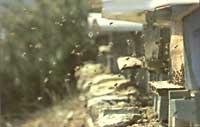
Before the hive comes out, more bees will be seen in front of the gate than other times in the form of clueless bees. Towards the afternoon there is a great congestion in the port and like a beard spend the night hanging from the outside of the port. These incidents can be seen the week before the hive leaves. Suddenly the bees enter the interior and soon the bees come out and form a ball. After a few hours, he moves away from there in a sudden flight to a new hole.
A week after this we will see a queen of the old hive come out towards noon and within a few minutes, returning in the tip of the body the germ organs of an erlamando. This input and output can be repeated.
While watching, you can also see the remains of some queen in the days following the departure of the hive. They are often white queen nymph even without coloring. Other innate queens murdered by the new queen.
Autumn
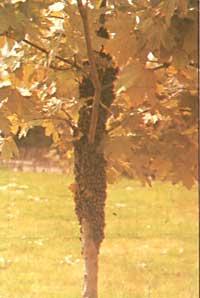
Towards autumn the activity is getting smaller. The day shortens and refreshes the night. Therefore, in the morning they are also taken back.
With the decrease in activity (which is linked to the decrease in food) the expulsion of the lamangos begins. Despite having a larger body and, despite entering the inside of the hive again and again above all operators, they are again expelled and the cold exterior lost.
Find bees in the urban environment
To know the bees it is not enough to be in the port of the hive. You also have to look at how they work outside.
Flowers like bee
is usually told to the girl or more to the nasty boy. That's not what you see first, that the bee is blooming, but don't think it works as you think. Look good and you realize that it only works in the same type of flower. Hence the above saying is not correct.
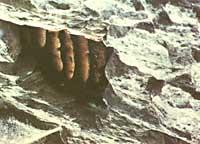
There are bees that seem to only smell the flower and do not pick up anything in appearance. Others, however, make pollen balls on the legs, once one color and another.
If we go to the port we see nothing more than putting the balls. But apart from those that collect colorful balls on the legs, we should empty the mouthpiece to know what others collect, and there would appear at least water, nectar and propolis.
Propolis is a varnish that forms in plant eyes and that bees use above all to close the slits. It is also a very good medicine.
He has seen fine monitors of bees on their leaves or around the acorn, where there are no flowers. Sometimes also around plant lice, like ants, collecting what is known as honey reed. Plant lice pierce leaves and other plant organs, and bees collect sweat from there. Bees also collect the sweet liquid from their own lice after eating vegetable sap. In other cases it is the plant itself that secretes this sweet liquid, as in the case of the acorn.
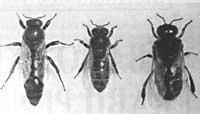
Those who are curious to know the bee also saw the bee in their windows. This bee does not attack anyone, it is in inspection. If there he found rice with milk, he would taste, fill the knob and return to the hive. But in a few minutes there will be more and more bee. Are they notified or followed?
In summer, they are also observed in explorations where there is no food, in the walls, logs and surroundings. They are exploratory bees, which the beekeeper is about to leave and for him they seek a new residence.
A local connoisseur may have found a bustling, bustling, bustling summer. Whoever has had the opportunity to meet him may be proud; he has found a meeting place for the erlamangos of that valley; a place where the erlamandos await the new queen.
In autumn, the mountaineer perceives the disappearance of the erlamangos. They remained out of a hive and lost freshness of night.
What inside the hive?
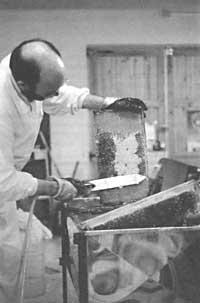
We have seen the bees moving near the port and around the hive, but we must consider these observations or oservations as superficial. What is really interesting is what happens inside the hive.
This mystery has remained hidden for thousands of years. Beekeepers only cared for bees in autumn when honey was removed. In summer they hunted hives and in hard winter they were given at most a sugary tempered wine or a porridge of beans.
Currently the situation has changed. To do this, the researchers have used in their work two resources: one, that of the glass hives (to see well what remains inside) and another, that of marking the bees. That is, placing on the back a drop of lacquer of different colors, or adding a number with tail, has been able to control each bee.
Proposal for an annual hive march
A beekeeper works as he himself wants in his hive and does not have to say how anyone should do it. After the last months of work and relationships I have come to this way of working. I present it here so that whoever wants to go forward can do it.
It is convenient that bees are very strong when honey arrives. That anyone knows. However, it is common that when honey arrives some are strong and some are very weak. Therefore, these strong collect honey and with the weak we try to strengthen it, but it is often useless.
In the fragile are those attacked by mycosis or sclerosis. The disease often sounds weak and the weak may be due to the bad queen.
The method presented here aims to eliminate the weak and give more strength to the strong.
On the other hand, the one who works with the hive Langstroth observes that he has honey in the furniture, but the lower one, the uterus, remains empty. Last year, in addition, we have seen that bees have had a lot of bee and babysitter, but they have barely collected honey. Rather, they have collected the honey, but one day they have collected it and spent on feeding the children.
To make a lot of honey it is necessary that the baby is blocked. That is what happens when there is a good and long time of honey. In Gipuzkoa the times of honey are often short and, perhaps, before placing them should block the uterus with artificial food. Saying is simple, but sometimes the block is followed by unlocking. There are big incidents in Gipuzkoa and it is difficult to block and block them. Let us take this idea as an orientation.
The incidence of months is variable in Gipuzkoa. What I say here is for the Coast. Those of Oñati may have a month delay. Not every year is the same and you can move forward or backward depending on the time.

JANUARY
If you have eaten enough inside, you have to leave the bees alone, slightly inclined forward so that the water or sweat do not remain at the base. Countertops must be tightly closed.

FEBRUARY
Place antibaroque tablets. Start giving a food incentive for the queen to start putting it. At first it would be enough with a half liter of syrup, sugar or honey and water in 1:1 ratio.

MARCH
Cleaning of bases. Continue to encourage food. Check the uterus to see if the queen lives. Change old uterine cells every 4 to 5 years. Thus, every two years, the uterus will be renewed. The black cells extracted from the uterus will not be used for honey, but we melt them. Better hygiene in the hive and less problems in winter with the cock.

APRIL / MAY
Remove ports. When honey arrives, eliminate the bad bees: those that have mycosis, those that have not been strengthened, such as B, C and F. Add the bad to the good bees after removing the queens. Give a lot of food and block it, the days before the placement of the hikes, when honey represents its strength.

JUNE
Monitor and control the benefit. Never leave the bee without room. Acquire new queens, create them or buy them. Hive capture. Administer anti-barroasis the same day of capture or before 4 days.
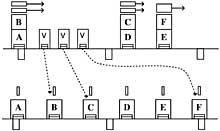
JULY / AUGUST
Collect honey by removing furniture. Do not leave without eating bee. Place antibaroque tablets. In the spring, the two drinking fountains that have joined together and in which they have run out of queen, new queens have been introduced. It also changes the queens of hives that have not worked properly.

SEPTEMBER / OCTOBER
Take care of the reservations and check that you are with the food you need for the winter.
Place metal ports against mice.
Leave the bees well covered in peace.November / December
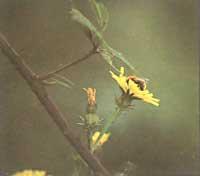
Buletina
Bidali zure helbide elektronikoa eta jaso asteroko buletina zure sarrera-ontzian











